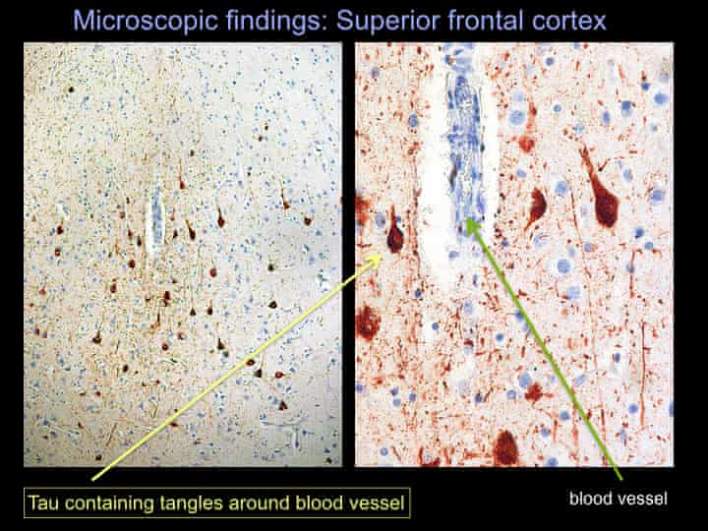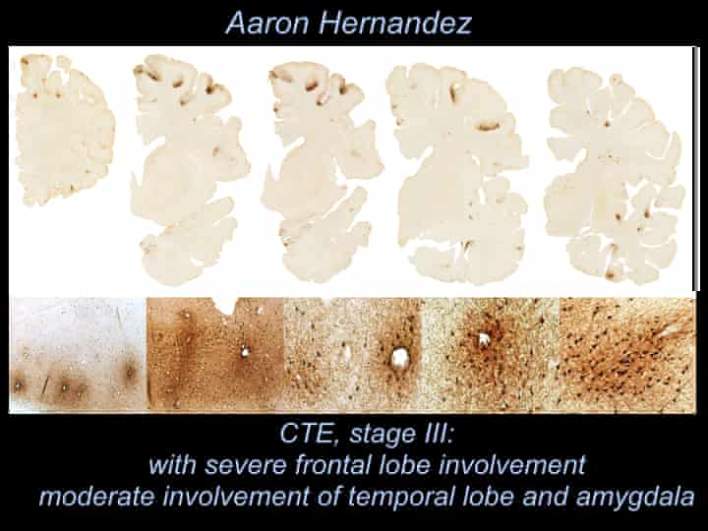
Aaron Hernandez had the worst case of CTE in a person his age that Boston University researchers had ever seen. The disease riddled his brain and even caused it to shrink.
The group of BU researchers studied the former NFL star’s brain after he committed suicide in 2017 while serving a prison sentence for homicide. A new Netflix series is exploring how CTE (chronic traumatic encephalopathy) may have affected Hernandez’s behavior. The affliction, caused by repeated blows to the head, can trigger aggressive and suicidal behavior, researchers have found.
The scene of Aaron Hernandez’s suicide was bizarre. He’d sketched references to the Illuminati on his prison wall in blood. He scrawled a Bible verse on his forehead. His suicide in a prison cell was a tragedy of Shakespearean proportions in and of itself. An athlete of such enormous talent had placed a ligature around his neck and hanged himself. He was also accused of other violent behavior, including a double homicide in Boston for which he was acquitted.
To be sure, other factors may have been at play, and the Netflix series explores these. Personal decisions. A desire to fit in with an unsavory crowd from back home in Bristol, Connecticut. A hidden gay lifestyle causing inner turmoil. Childhood abuse, both physical and sexual. His mother’s chaotic relationships. His father’s early death.
Boston University researcher Ann McKee said in a news release that “while I’m not going to connect the dots with his behavior or difficulties during life…the frontal lobes—and his were very severely affected—are involved in problem-solving, judgment, impulse control, and social behavior. The amygdala, which was affected in Aaron Hernandez as well, is involved in emotional regulation, emotional behavior, fear, and anxiety.” (You can read about the CTE suffered by former NFL player Junior Seau here. It’s also discussed in the Netflix documentary.)
How bad was Aaron’s CTE? What do photos reveal of his brain disease?
Here’s what you need to know:
Hernandez’s Brain Was ‘Riddled’ With Stage 3 CTE to a Degree That Surprised Researchers

BU/Dr. Ann McKeeOne of Dr. Ann McKee’s scan of Hernandez’s brain.
Boston University conducted the research into Hernandez’s brain after his suicide. The university said in a news release that its expert found that Aaron Hernandez “suffered from chronic traumatic encephalopathy (CTE) to a degree never before seen by BU researchers in such a young person.”
His brain was “riddled” with stage 3 CTE to a degree “that we’ve never seen…in our 468 brains, except for individuals very much older,” Ann McKee, director of BU’s Chronic Traumatic Encephalopathy Center, told a news conference in 2017. “Individuals with similar gross findings…were at least 46 years old at the time of death.”
Hernandez was 27.

One of Dr. Ann McKee’s scan of Hernandez’s brain.
According to Boston University, “Chronic Traumatic Encephalopathy (CTE) is a progressive degenerative disease of the brain found in people with a history of repetitive brain trauma (often athletes), including symptomatic concussions as well as asymptomatic subconcussive hits to the head that do not cause symptoms. CTE has been known to affect boxers since the 1920’s (when it was initially termed punch drunk syndrome or dementia pugilistica)…The repeated brain trauma triggers progressive degeneration of the brain tissue, including the build-up of an abnormal protein called tau.”
“Especially in the frontal lobes, which are very important for decision-making, judgment, and cognition, we could see damage to the inner chambers of the brain,” McKee said. “This would be the first case we’ve ever seen of that kind of damage in such a young individual.”

One of Dr. Ann McKee’s scan of Hernandez’s brain.
Aaron’s brain showed deposits of the protein tau, which is associated with CTE, and “other evidence of the disease,” including dilated ventricles, which indicates “the brain had shrunk,” and an atrophied fornix, (nerves associated with memory.) This was caused by “repetitive brain trauma,” said McKee, adding that “in every place that we looked, it was classic CTE. This is substantial damage that undoubtedly took years to develop.”
The press release notes that more than 100 former National Hockey League players have sued the NHL, “seeking medical benefits on the grounds that the league should have known about diseases like CTE.”

One of Dr. Ann McKee’s scan of Hernandez’s brain. This is Hernandez’s brain scan: The top shows the deposits of tau protein associated with CTE. The bottom shows tau protein in nerve cells around small blood vessels.
McKee said she couldn’t “connect the dots” between Aaron’s murder case and his CTE, but she said, “In any individual we can’t take the pathology and explain the behavior. But we can say collectively, in our collective experience, individuals with CTE and CTE of this severity have difficulty with impulse control, decision-making, inhibition of impulses or aggression, often emotional volatility and rage behaviors.”
Aaron’s Fiancee Filed a Lawsuit Against the NFL on Behalf of Their Minor Child But It Was Dismissed

InstagramAvielle Hernandez now (right) with her mother and half sister.
The lawsuit that Shayanna Jenkins Hernandez, Aaron’s fiancee and the mother of his child, filed on behalf of their daughter Avielle Hernandez, says that “at the time of his death, Aaron had the most severe case of Chronic Traumatic Encephalopathy (‘CTE’) medically seen in the world renowned CTE Center at Boston University in a person of Aaron’s young age.”
The lawsuit says that Aaron had “Stage III CTE usually seen in football players with a median age of death of 67 years.”
Aaron “began playing youth football when he was about 5 years old. He played youth football in Connecticut, middle school football, high school football, collegiate football at the University of Florida and professional football in the National Football League for the New England Patriots for three seasons starting in 2010,” the lawsuit says.
The lawsuit says that football “is a potentially deadly and imminently dangerous delivery-mechanism for exposure to repeated blows to the head.”
The Center for Disease Control says CTE’s typical signs and symptoms include “decline of recent memory and executive function, mood and behavioral disturbances (especially depression, impulsivity, aggressiveness, anger, irritability, suicidal behavior and eventual progression to dementia.)”
The lawsuit adds that the defendants’ “actual and/or constructive knowledge of CTE dates back at least to the 1960s; the general public’s knowledge of CTE does not.”
In the 1960s, football “was examining the scope and nature of its brain injury problems” and the government had already studied CTE. The lawsuit labels the defendants’ actions a “long-running conspiracy” designed to “insulate them all … from litigation and financial responsibility. Aaron relied to his detriment on the representations made by the intentional-concealment-fraud and conspiracy.”
Studies of athletes in 1928 observed a link between repetitive exposures to head trauma, certain clinical manifestations, and a pathologically unique tangling of tau protein deposits on the brain. Pathologist Harrison Martland described the clinical spectrum of abnormalities (“cuckoo,” “goofy” etc.) found in “almost 50 percent of fighters (boxers),” the lawsuit says.
CTE was first called “punch drunk syndrome.” By 1952, a prominent neuropsychiatrist was studying CTE in a closed head injury cohort of Korean war veterans at Walter Reed Hospital.
In total, Aaron played football for 19 years, says the lawsuit.
He “experienced repeated traumatic head impacts, including subclinical and clinical blows, with greater frequency and severity than the general population of men of a similar age,” says the lawsuit.
There are four worsening stages of brain degeneracy in CTE.

FOXBOROUGH, MA – CIRCA 2011: In this handout image provided by the NFL, Aaron Hernandez of the New England Patriots poses for his NFL headshot circa 2011 in Foxborough, Massachusetts. (Photo by NFL via Getty Images)
People with CTE Stage III like Aaron “typically experience symptoms such as memory loss, executive dysfunction, aggression, explosive behavior, loss of concentration, mood swings, depression, apathy, and cognitive impairment,” says the lawsuit.
The judge dismissed the lawsuit. Her argument was basically that Hernandez was essentially retired at the time of his death and the lawsuit, so his daughter didn’t qualify to sue the NFL over his CTE.
Hernandez’ death was officially ruled a suicide on April 20, 2017. According to Yahoo, the judge found that “Hernandez fit into the definition of a ‘retired player’ under the settlement agreement, and failed to properly opt out of the class action settlement.”
His family pushed for the research into his brain. The family “had arranged for Boston University researchers looking at brain trauma in athletes to take possession of Hernandez’s brain following the autopsy,” reports ESPN, quoting the Hernandez’ family attorney, Jose Baez.
According to NBC News, the family wanted Hernandez’ brain studied for CTE, which is “a degenerative brain disease that has been linked to athletes, including football players, who might suffer concussions and head trauma.” It can only be diagnosed after death and can be linked to suicide, reports NBC.
The family wanted the brain to go to Boston University’s Chronic Traumatic Encephalopathy Center. “The center studies a progressive degenerative brain disease found in some athletes who have experienced repetitive brain trauma,” reports People Magazine.
Hernandez’s death scene contained odd details.
For one, Hernandez drew a Bible verse on his forehead.
Hernandez “wrote ‘John 3:16’ on his forehead and left notes to his 4-year-old daughter and his fiancee beside an open Bible in the prison cell where he hanged himself,” reports the Boston Herald.
The verse reads, “For God so loved the world, that he gave his only begotten Son, that whosoever believeth in him should not perish, but have everlasting life.”

(Getty)
According to WCVB, that’s not the end of it. Hernandez drew images in blood on his cell, the TV station reports. “One of the drawings was what’s known as the unfinished pyramid and the all-seeing eye of God. The image is similar to what is found on the back of U.S. currency,” reports WCVB, adding that Hernandez wrote “ILLUMINATI” in capital letters below the image.
“The illuminati is a person or group claiming to have religious enlightenment or knowledge. The illuminati has also been the subject of several theories, including one that claims they control of the world,” reports WCVB, which adds, “Above the pyramid, Hernandez drew an oval with rays coming from the edges.”
READ NEXT: Jonathan DJ Hernandez, Aaron’s Brother.
Comments
Aaron Hernandez & CTE: Photos Show Severe Brain Damage